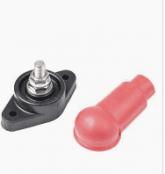Looking for feedback on my battery wiring design. I'll have 4 12v 280Ah batteries in DIY enclosures. Overkill BMS's for each battery and I estimate total system load to be max of 250amps continuous worst case (typically much lower). This is going in a van. I was planning on just having lugged leads exiting each battery case rather than putting posts on the batteries. Looking to parallel each pair of batteries at 4 way battery switches and posts for negatives and then basically paralleling again back to the master disconnect and to the shunt. The batteries will be mounted on the rear van wall very similar to the picture with 3 batteries stacked and the 4th to the right sitting over the wheel well. The wire runs should be similar enough that I can match the lengths. A few questions/concerns I have:
Are the 4way switch "combiners" a significant source or resistance or failure? I need to combine the batteries with something and I like the idea of being able to take a battery (or batteries) out of service if there is an issue. It's also seems like a clean way to keep the high current positive lugs shielded.
I was thinking about just using the negative leads straight from my BMS to the buss/post to combine before the main run to the shunt. They will probably be about 12-18" long and they are 3x 8AWG wires. The alternative is to consolidate the leads inside the battery enclosure to a terminal and that would reduce their length to ~6inches and I could run a bigger wire from there.
Similar question on the positive leads from the battery. These runs should be under 18" and shouldn't see more than ~60a continuous.
Similar sizing question on the main runs - do I really need 4/0 when I'm splitting the load or is it a waste for ~120a continuous on each wire? I was thinking if the battery leads are a little undersized, I'm compensating a bit with the main runs. I've looked at some of the voltage drop charts, I'm just not clear on where the cost/benefit tradeoff is.
Fusing - Do I need to add one of those big terminal fuses for each battery? I've seen some installs that have this and others that don't. I know the BMS's have some short circuit protection, but not sure what is best practice here. I don't want to cheap out if it's a safety concern, but I also don't want to overengineer and add complexity. Any advice on fusing is appreciated.
Any other feedback/criticism/recommendations are appreciated.

Are the 4way switch "combiners" a significant source or resistance or failure? I need to combine the batteries with something and I like the idea of being able to take a battery (or batteries) out of service if there is an issue. It's also seems like a clean way to keep the high current positive lugs shielded.
I was thinking about just using the negative leads straight from my BMS to the buss/post to combine before the main run to the shunt. They will probably be about 12-18" long and they are 3x 8AWG wires. The alternative is to consolidate the leads inside the battery enclosure to a terminal and that would reduce their length to ~6inches and I could run a bigger wire from there.
Similar question on the positive leads from the battery. These runs should be under 18" and shouldn't see more than ~60a continuous.
Similar sizing question on the main runs - do I really need 4/0 when I'm splitting the load or is it a waste for ~120a continuous on each wire? I was thinking if the battery leads are a little undersized, I'm compensating a bit with the main runs. I've looked at some of the voltage drop charts, I'm just not clear on where the cost/benefit tradeoff is.
Fusing - Do I need to add one of those big terminal fuses for each battery? I've seen some installs that have this and others that don't. I know the BMS's have some short circuit protection, but not sure what is best practice here. I don't want to cheap out if it's a safety concern, but I also don't want to overengineer and add complexity. Any advice on fusing is appreciated.
Any other feedback/criticism/recommendations are appreciated.




